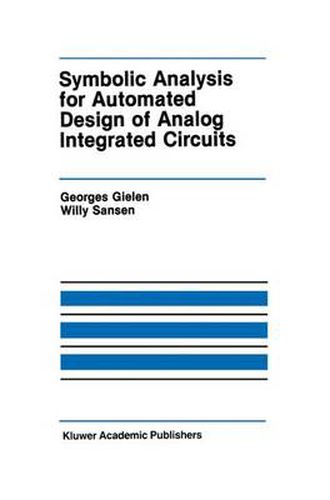Readings Newsletter
Become a Readings Member to make your shopping experience even easier.
Sign in or sign up for free!
You’re not far away from qualifying for FREE standard shipping within Australia
You’ve qualified for FREE standard shipping within Australia
The cart is loading…






This title is printed to order. This book may have been self-published. If so, we cannot guarantee the quality of the content. In the main most books will have gone through the editing process however some may not. We therefore suggest that you be aware of this before ordering this book. If in doubt check either the author or publisher’s details as we are unable to accept any returns unless they are faulty. Please contact us if you have any questions.
It is a great honor to provide a few words of introduction for Dr. Georges Gielen’s and Prof. Willy Sansen’s book Symbolic analysis for automated design of analog integrated circuits . The symbolic analysis method presented in this book represents a significant step forward in the area of analog circuit design. As demonstrated in this book, symbolic analysis opens up new possibilities for the development of computer-aided design (CAD) tools that can analyze an analog circuit topology and automatically size the components for a given set of specifications. Symbolic analysis even has the potential to improve the training of young analog circuit designers and to guide more experienced designers through second-order phenomena such as distortion. This book can also serve as an excellent reference for researchers in the analog circuit design area and creators of CAD tools, as it provides a comprehensive overview and comparison of various approaches for analog circuit design automation and an extensive bibliography. The world is essentially analog in nature, hence most electronic systems involve both analog and digital circuitry. As the number of transistors that can be integrated on a single integrated circuit (IC) substrate steadily increases over time, an ever increasing number of systems will be implemented with one, or a few, very complex ICs because of their lower production costs.
$9.00 standard shipping within Australia
FREE standard shipping within Australia for orders over $100.00
Express & International shipping calculated at checkout
This title is printed to order. This book may have been self-published. If so, we cannot guarantee the quality of the content. In the main most books will have gone through the editing process however some may not. We therefore suggest that you be aware of this before ordering this book. If in doubt check either the author or publisher’s details as we are unable to accept any returns unless they are faulty. Please contact us if you have any questions.
It is a great honor to provide a few words of introduction for Dr. Georges Gielen’s and Prof. Willy Sansen’s book Symbolic analysis for automated design of analog integrated circuits . The symbolic analysis method presented in this book represents a significant step forward in the area of analog circuit design. As demonstrated in this book, symbolic analysis opens up new possibilities for the development of computer-aided design (CAD) tools that can analyze an analog circuit topology and automatically size the components for a given set of specifications. Symbolic analysis even has the potential to improve the training of young analog circuit designers and to guide more experienced designers through second-order phenomena such as distortion. This book can also serve as an excellent reference for researchers in the analog circuit design area and creators of CAD tools, as it provides a comprehensive overview and comparison of various approaches for analog circuit design automation and an extensive bibliography. The world is essentially analog in nature, hence most electronic systems involve both analog and digital circuitry. As the number of transistors that can be integrated on a single integrated circuit (IC) substrate steadily increases over time, an ever increasing number of systems will be implemented with one, or a few, very complex ICs because of their lower production costs.